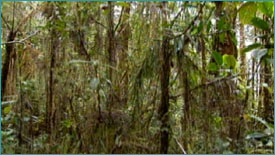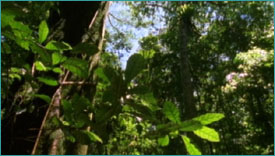 |
 |
|
|  Do the remote mountains of New
Guinea hold as yet undescribed species of bowerbirds? Borgia says it's
possible.
Do the remote mountains of New
Guinea hold as yet undescribed species of bowerbirds? Borgia says it's
possible.
|
On the Trail of the Bowerbird
Part 3 | Back to Part 2
NOVA: Do you think there are new bowerbird species left to discover?
Borgia: It's possible. I think what may happen is that existing species may be
split. Certainly with the Vogelkop bowerbirds that may be the case. Albert Uy
and I had a paper in Evolution in which we showed that patterns of mate
choice seem to be different in the two populations we looked at in New Guinea,
one in the Arfak Mountains, the other in the Fakfak Mountains. With these
different modes of sexual selection going on it seems reasonable that these are
different species. Certainly the bowers are decorated differently and built
differently. Those are probably different species, and there are probably
similar scenarios going on with other populations and other species of
bowerbirds.
NOVA: I've heard bowers are difficult to find. When you are doing research how
do you go about locating them?
Borgia: It depends on the species you're working with. In satin bowerbirds the
males call from their bowers, and the males aren't located very far apart, so
when you hear a calling male you can simply go to the vicinity of that call.
Otherwise, you just have to know what you are looking for. Often a bower is
near a log. You can get a good idea of where bowers might be, and then they are
not too hard to find. Sometimes the hard part is just getting through dense
vegetation. For a species like the spotted bowerbird it tends to be a little
harder because the bowers are located very far apart, on the order of a
kilometer. So there is a lot of area you have to cover in order to find the
bower.
 Fighting through dense jungle can be
the hardest part of finding bowers, Borgia says.
Fighting through dense jungle can be
the hardest part of finding bowers, Borgia says.
|
|
NOVA: Once you have found a bower and are studying a particular bird, what is a
typical day in the field like? Are you and your students sitting around not
moving a muscle for hours on end?
Borgia: Well, it depends what we are trying to accomplish in the study. The
study that we are running on satin bowerbirds at our Wallaby Creek site in
Australia has a heavy concentration of cameras being used. We set up cameras at
approximately 36 different bowers and separate the bowers into different
routes. A person has to come by and check the cameras on that route twice a
day, count decorations at least once a day, and report the numbers on certain
decoration types and see if they have been stolen or moved also once per day.
If necessary, we also have to change the car batteries we use to power the
equipment. Midday we do a lot of observation—about five or six hours' worth.
We are usually out from dawn to dusk with one half-day off per week.
NOVA: What have been some of your most exciting moments while studying
bowerbirds?
Borgia: Well, every year I come back with just wonderful moments. It was
exciting the first year when I saw my first bowerbird copulation, because when
we started people rarely saw copulations in satin bowerbirds and probably not
at all in most other species. And what we wanted to do was collect data using
numbers of copulations, so it was important that we could see copulations
regularly in these birds. It was incredibly exciting this past year just
finding all these bowers of varying kinds and discovering that some spotted
bowerbirds show traits thought to exist only in other species, such as putting
decorations on top of the bower wall, which had only been seen in fawn-breasted
bowerbirds.
|  Every time he returns to the forests of Australia or New Guinea, Borgia observes bowerbird behaviors he's never seen before.
Every time he returns to the forests of Australia or New Guinea, Borgia observes bowerbird behaviors he's never seen before.
|
Another thing that happened this year is that I found a bird that had almost
what I would call an Indian sand painting the way he displayed his decorations.
Right in front of the bower he had a filled-in arc of exclusively green
decorations, and then an area beyond that included white bones and blue grass,
and finally flanking that on each side was red plastic. So this bird, over a
two-and-a-half meter area, was building this kind of wonderful display by
laying the colors out in a very symmetrical and phenomenal way. It was
incredible to me, you know, even after having worked on these birds for more
than 20 years.
Interview conducted by Peter Tyson, editor in chief of NOVA Online
Photo credits
On the Trail of the Bowerbird |
Are Bowers Art? |
Creature Courtship
Bowerbird Matching Game |
Resources |
Teacher's Guide
Transcript |
Site Map |
Flying Casanovas Home
Search |
Site Map |
Previously Featured |
Schedule |
Feedback |
Teachers |
Shop
Join Us/E-Mail |
About NOVA |
Editor's Picks |
Watch NOVAs online |
To print
PBS Online |
NOVA Online |
WGBH
© | Updated December 2001
|
|
|
|